Symmetry, Unification and Developments on Long-Range Gravitational Field and Electromagnetic Field
1Department of Physics, School of Physics and Astronomy, Yunnan University, Kunming, China .
Corresponding author Email: yfc50445@qq.com
First, there has similar electrodynamics in general relativity. Next, the electromagnetic general relativity may be obtained. By the same method of equivalence principle for the electromagnetic field, whose curvatures are different for different ratios of charge to mass. We discussed the four possible tests. Third, for long-range gravitational field and electromagnetic field we research various unifications. Fourth, we discuss the quantization of these unified theories. Finally, nonlinearity and the negative matter are discussed. We believe that these investigations are all a broad space for exploration, and some potential application values.
Copy the following to cite this article:
Chang Y. F. Symmetry, Unification and Developments on Long-Range Gravitational Field and Electromagnetic Field. Oriental Jornal of Physical Sciences 2024; 9(1).
Copy the following to cite this URL:
Chang Y. F. Symmetry, Unification and Developments on Long-Range Gravitational Field and Electromagnetic Field. Oriental Jornal of Physical Sciences 2024; 9(1). Available here: https://bit.ly/4b05S4b
Citation Manager Publish History
Select type of program for download
| Endnote EndNote format (Mac & Win) | |
| Reference Manager Ris format (Win only) | |
| Procite Ris format (Win only) | |
| Medlars Format | |
| RefWorks Format RefWorks format (Mac & Win) | |
| BibTex Format BibTex format (Mac & Win) |
Article Publishing History
| Received: | 15-12-2023 |
|---|---|
| Accepted: | 28-02-2024 |
| Reviewed by: | 
 Prof. H.S. Lee
Prof. H.S. Lee |
| Second Review by: |

 K.G Rewatkar
K.G Rewatkar |
| Final Approval by: | Dr. J. Ajayan |
Introduction
It is generally believed that the long-range gravitational fields and electromagnetic fields have been very mature and complete. For example, electric field E and magnetic field B have the symmetry 1. Of course, there is also electrical and magnetic asymmetry, such as so far the magnetic monopole has not been found.
In order to unify the gravitational and electromagnetic fields, Einstein, et al., applied various geometrical structures and theoretical schemes, for example, the gauge invariance geometry, the five-dimensional space-time, the projective theory, the affine field and the bivector fields, etc 2. Hlavaty made the summary and development 3. The unified field theories of more than four-dimensions were summarized 4. These schemes 2-4 include high-dimensional field, multiple fields (Newton gravity is scalar field, and general relativity is a tensor field), higher-order equations, the affine fields of non-European geometry, and nonlinearity, quantization, etc. In this paper for long-range gravitational field and electromagnetic field we research similar electrodynamics in general relativity and the electromagnetic general relativity, and discuss their symmetry, unification and developments.
Similar Electrodynamics in General Relativity
First, gravitational field and electromagnetic field are all the long-range interactions. Next, it is well-known that Newton gravitation and Coulomb electrostatic force are completely symmetry. And both develop to general relativity and electrodynamics. In general relativity Einstein [2] and Landau [5] derived some similar formulas of electromagnetic theory, for example, the similar Lorentz formulas 2,5:

Here s = g44/2 = - j/ c2 , u =ig4a. In this2 case, moving charge produces magnetic field, which is analogy to moving object produces a similar magnetic field, such as a rotation with angular velocity w = -(rotu / 2c), which is similar with Coriolis force.
Landau derived 5:

Here h = -g00, ga = - / ga0
In general relativity the Einstein gravitational field equations are:

The corresponding geodesic equation of motion is:

For Eqs.(1)(2) let ui = (u; is) = i(g 4a; g44 /2) = - (Am; ij)/c2, we introduce two similar inductions for gravitational field:

Such we derive a similar formula:
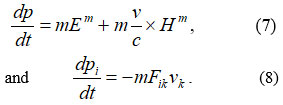
This vortex field can exist independently, and corresponds to hydrodynamics, in which has also vortex conservation. Further, we may develop the corresponding Lorentz equation and general like electromagnetic fields and their theories. This includes analogous systems of Maxwell equations and magnetic monopoles, etc.
The corresponding similar first system of Maxwell equations is:

It is analogous completely to the Bianchi identities. Eq.(9) includes

The corresponding similar second system of Maxwell equations is:

It includes
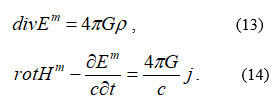
Therefore, general relativity has various similar formulas of electrodynamics. Such gravitational wave can be obtained by similar to electromagnetic wave.
Of course, we must also be attention to the difference between them, that is, symmetry breaking, and have mainly the opposite direction. It seems to originate from the Newtonian gravity and Coulomb force sign is opposite, namely m becomes to -e.
Electromagnetic General Relativity
Further, we derived the electromagnetic general relativity 6. By the same method we introduced an equivalence principle for the electromagnetic field:

This can be derived the electromagnetic general relativity, which is a curved space-time for charged bodies, whose curvatures are different for different ratios of charge to mass. In a general case, it can obtain electrodynamics, but its high-order approximation will deviate from the present electromagnetic theory.
From this we may discuss the four possible tests for this theory: First, a change of space-time should exist in the electromagnetic field. Such as a magnetic field is equivalent to a rotating system, the change of time will be

Here positive or negative signs show different motions along clockwise or anticlockwise directions. According to relativity, the energy of a charged body changes in an electromagnetic field, so its mass and corresponding space-time should change too. In a composite field

The time r = /g00 t0, so the electromagnetic field changes the space-time of any charged bodies. Second, the frequency w0 of charged oscillator in a constant magnetic field becomes 5

According to quantum electrodynamics (QED), various big changes may occur in the electromagnetic field, and the frequencies of photons will change for the scattered photons in the changeable electromagnetic field. Third, the propagation of a light ray depends on 5

in a static gravitational field. In the electromagnetic field g00 = 1 for light, so the light ray propagates along a geodesic line. But, interactions among photons and photons exist in a strong electromagnetic field, so the light ray will deflect, and the speed of light will be changeable. Charged particles in a Coulomb field move, respectively, along an ellipse for the moment of momentum K>|ee'|/c, and along a hyperbola for K<|ee'|/c 5. These effects correspond to a shift in the perihelion of the orbit and the deflection of light ray. In the gravitational field the equation of the deflection of light ray is

where u=1/r. The angle of deflection is:

The moment of momentum K=mcR of photon is introduced, so

In the Coulomb field produced by a rest charge e', the equation for a charged particle with charge e and moment of momentum K>|ee'|/c is

In the attractive case of ee'<0, the angle of deflection of particles with relativistic motion is

In the repulsive case of ee'>0,

Eqs.(24) and (25) become the same, 0 = 2ee/ v0K for scattering with small angles. This result is only a half of the deflected angle in general relativity. In QED the elastic scattering of charged particles in a centrally symmetric Coulomb field obeys Rutherford's theory, in which the deflected angle agrees with ctg(0/2) = m0bv2 / 2ee. For scattering with a small angle ctg(0/2) ≈ 2 /0

It is the same as the result of general relativity. Fourth, the general particles in general relativity and the general charged particles in the electromagnetic general relativity move along geodesic line. When these particles move along non-bound orbits, the angle of deflection is

Ø>0 corresponds to an attractive force; while Ø<0 corresponds to a repulsive force [5]. When these particles move along bound orbits in a centrally symmetric attractive field, there results a precession of the perihelion. In general relativity, the equation for the shift of the perihelion becomes

in which the angular distance between two successive perihelions is

In a centrally symmetric electromagnetic field, the final form of equation for the precession on the charged particle for Kc>|ee'| becomes5

in which the angular distance is

This is consistent with a result combining special relativity and the gravitational field of the scalar quantity 7, which is just a sixth of the corresponding value in general relativity and in the electromagnetic general relativity. Because of the easy control of the electromagnetic field, the theory can be tested accurately in experimental laboratories. Further, we proposed the most universal principle of extended equivalence and the extended general relativity 6.
The developed relations of these theories are 8
Newton gravitation →(similar electromagnetic force and theory ß) general relativity
Coulomb static force → Lorentz force and electrodynamics → electromagnetic general relativity 6
The above framed theory has been completed, while the no-framed theory is being explored.
Various Unifications on Electromagnetic Field and General Relativity
The gravitational field and the source-free electromagnetic field can be geometric unified by the equations 9,10:

in the Riemannian geometry, both are contractions of im and ik, respectively. It includes Rlm =0, from which we can obtain the Lorentz equations of motion, the first system and second source-free system of Maxwell field equations. This unification can be included in the gauge theory 9,10. Another unification on the general nonsymmetric metric field is high-dimensional space-time. We proposed an imaginative representation on the ten dimensional space-times 10.
In general relativity,

all are symmetric. But, in electrodynamics,

are antisymmetric. This has some similar characters with torsion.
Therefore, the macro-field of the world is unified. This is the Einstein non-symmetric field 2. It is the logically simplest. The only symmetric part is gravitational field and general relativity; the antisymmetric part is electromagnetic field and the electromagnetic general relativity 6. The mathematics of unified gravitational and electromagnetic fields should be general

In the 4-dimensional 16 elements, 10 symmetries are gravitational fields, and 6 antisymmetries are electromagnetic fields.

General space is ds2 = gµv dx µ dxv For gravitational
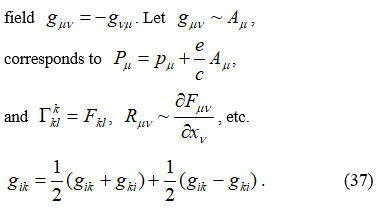
It may be divided into symmetric and antisymmetric parts. Particles have spin and spinor, and some fields have rotation as rot A.

may be divided into symmetric and antisymmetric parts, both have respectively with 40 degrees of freedom and 24 degrees of freedom, in which antisymmetric part

is called torsion. It corresponds to spin tensor 11.
Quantizations of These Unified Theories
For (xa; x0 = ct), LT is symmetric matrix:
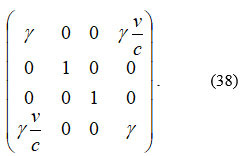
Based on general relativity s2 = gμv xμ xv, we proposed the quantum equations of general relativity are 12,13:
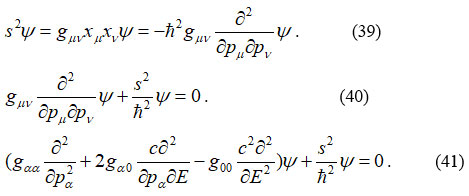
We proposed general equations possibly are 12,13:

It is quantum non-symmetric tensor. In Eqs.(42)(43) left and right sides are eigenmatrix and eigenvalues of the eigenequations. Both are all quantization.
Relativity may be the vector, tensor, torsion, and all spatial properties. Quantum theory is the spinor with two-component, and related to the Pauli matrix.
Quantum field and QED should have the corresponding magnetic field. Further, QED may be developed to QGT.
The metric matrix of the symplectic geometry is antisymmetric, so the electromagnetic field should be the symplectic geometry. The unification of gravitational and electromagnetic fields will be a unification of symplectic geometry and Riemannian geometry.
Further, electrodynamics in quantum theory develops to QED. We proposed that gravitation theory should correspond to develop quantum gravitation theory (QGT).
Quantum unification first must develop QED to gravity and general relativity.
It is first generalized to the gravity theory QGT by some ways exactly like QED. Then QED and QGT will be combined and unified. It may combine the gauge field and Utiyama field [15].
The juxtaposed strong and weak interactions and their interactions each other, whose Lagrangian is:

For QED:

and Dirac equations.
For QGT:

or electrons as the smallest static mass particle, whose Lagrangian and Eq.(45) are the same. The difference is only attributed to the interaction Lin. 1. The Culomb force resembles Newton gravity. 2. The potential is developed to 4-vector Aµ, and corresponds to the rotational field. 3. Quantum Lin are difference. For QED Lin = ie¥+ y4 yµ¥Aµ. For QGT Lin = im¥+ y4 yµ¥Aµ. From this we may derive similar equations. Both are unified

The present interaction unifications are mainly based on the YM field and its generalized gauge theory. For SU(2) gauge group, Lagrangian of YM field is:

where F µv = ôv bµ -ôµ bv - 2εbµ xbv. It is also Lagrangian of weak interaction 15.
QED Lagrangian by renormalization is:

Strong interaction should also add Lagrangian

Quark Lagrangian with SL(6,C) gauge invariance is 16:

In gravitational field, Lagrangian of classical lepton field is 17:

For the same case Lagrangian of strong interaction is 17:

The simplest Lagrangian of the unified four-interactions is probably:

where

is the connected covariant curl.
So far, QED may obtain best results: Lamb shift. Dirac equations in electromagnetic field may obtain the magnetic moment

The anomalous magnetic moments µ of electron by the renormalization theory is:

Here C2 ≈ 0.328479 18, C3 ≈ 1.183, etc. So far, the experimental μ = 1.0011596521859, and the theoretical μ =1.001159652460 19.
Developing curved space-time lead to anomalous magnetic moments, which is also a unity of quantum mechanics and general relativity.
Dirac equations in gravitational field should be:

This should obtain some similar results. It may develop to in curved space.
When A=0, Eq.(56) is simplified to

Schrödinger equation in gravitational field is:

For gravitational field V = mø.
Let V=mgz is a linear potential 20. Its energy level

They can extend to QGT. If the hydrogen atom changes into a gravitational field, it will give exactly the same form. This is similar to the solar system, and to unify the electromagnetic field and the gravitational field.
In strong magnetic field there has Zeeman effect. In strong gravitational field there has gravitational red-shift. Both are differences. But, conversely, the two can be contrasted developed, such as we may research the similar Zeeman effect in the gravitational field and the red-shift and other tests in the electromagnetic field.
According to the classical electromagnetic theory the frequency of charged oscillator in a constant magnetic field becomes 5:

According to quantum electrodynamics (QED), various big changes may occur in the electromagnetic field.
Further, they may be extended to QED and QGT. It may be related to the loop and other quantum gravity theories.
In QED, photon-electron interactions have the photoelectric effect, Compton scattering, etc. In QGD, it corresponds to the interaction between gravity and photon-electron, namely, the extremely strong gravitational field, such as neutron star, black hole, accretion disk, etc. These are interactions with the electromagnetic field and charge. Black holes produce Hawking radiation; neutron stars produce various pulsars from optics to X and gamma ray. PSR1913+16 pulsed binary conversion between gravitational field and electromagnetic field. Many phenomena of quasars, and even optical astronomy, are mutual transformations between the two fields.
A possible unification of two fundamental theories (Quantum Mechanics and General Relativity) is Quantum Gravity (QG), whose phenomenology studies QG effects in low-energy systems. A basic model is a modified Heisenberg uncertainty relation and predicts a deformed canonical commutator. Bosso computed Planck-scale corrections to angular momentum eigenvalues, the hydrogen atom spectrum, the Stern-Gerlach experiment, and the Clebsch-Gordan coefficients, and analyze the GUP-perturbed harmonic oscillator and study new coherent and squeezed states. He introduced a scheme for increasing the sensitivity of optomechanical experiments for testing QG effects, and suggested future projects that may potentially test QG effects in the laboratory 21.
Macro 10 dimensions are possibly the gravitational field (3+1), electric field E and magnetic field H (B) each 3 dimensions. The 4-dimensional non-symmetric field unifies the gravitational and electromagnetic fields.
The 5-dimensional non-symmetric field can again unify the strong and weak short-range interaction field, and corresponds to the grand unified theory (GUT) of SU (5).
The micro-dimensions should be 25-16=9, so the strong and weak interactions each have 4, which corresponds to 4 basic particles (p, e, v, y), plus 1 for unity.
Gravitational field strength g corresponds to mass m, and electromagnetic field strength corresponds charge e and e2/hc =1/137, and strengths of strong-weak interactions correspond to p(v) ~ g2/ hc, and are related to the running coupling and the asymptotically freedom G=0, etc 22,23.
Strength ratio of electromagnetic field to gravitational field is

is 1040. This ratio is maximum for electron, and minimum for proton.
The gravity and electrostatic force of n-dimensional space are proportional to rn-1. So high-dimensional strings are difficult to hold up, or they must have new results 24.
The fine-structure constant is a = e2/ hc =(137.036)-1. Planck time is:

the Planck length is:

Both already open a relation on unification of four interactions, in which G, c and h correspond respectively to gravitational, electromagnetic and microscopic strong-weak interactions.
Gravity should first be unified with QED. How can Maxwell equations and Lorentz equation be expressed or developed in QED? Further it is possible to unify the strong-weak interactions.
Graviton may determine only m=0. Why is the spin s=2? How to determine that?
1. If spin approximate s=1, such corresponds to QED. 2. Conversely, QED develops to s=2. 3. It is currently known are: Graviton, s=2; Photons s=1, both are long-range interactions; W-Z and gluon are all s=1. It corresponds to GUT.

and W-Z symmetry, SU(3) and SU(2) symmetry. It may correspond to symmetry and unification of the short-range strong-weak interactions, and may be unified to the gauge field.
The fermions include basic neutrino v, electron e and proton p, which are all s=1 / 2, masses is 0, small, large. They determining weak, electric, strong interactions, and all can be quantized.
Nonlinear Theory and the Negative Matter
Einstein pointed out, the true law cannot be linear. He always believes the nonlinear theory. General relativity is already the nonlinear theory, but so far quantum mechanics is usually linear, such both unification must be nonlinear quantum theory.
These theories may develop to nonlinear, such as nonlinear electrodynamics and QED, nonlinear optics, nonlinear quantum mechanics 24, etc. They include various solitons, fractal and chaos. Gravitational wave may develop to nonlinear gravitational waves 25, etc.
Further, various unifications of four interactions should be the nonlinear theories. First, we must develop the nonlinear electromagnetic and strong-weak theories.
So far there is only one mass, but are two charges. Based on Dirac negative energy, Einstein mass-energy relation and principle of equivalence, from 2007 we proposed the negative matter as the simplest model of unified dark matter and dark energy 26-35, whose main characteristics are the gravitation each other, but the repulsion with all positive matter. So all theories are known, only mass includes positive and negative. Because there is repulsion between positive matter and negative matter, so which is invisible dark matter, and repulsion as dark energy. Further, we derived that the rotational velocity of galaxy is approximate constant, and an evolutional ratio between total matter and usual matter from 1 to present 11.82 or 7.88 33-35. We calculated the accelerated expansion at 9.760 billion years. The mechanism of inflation is origin of positive-negative matters created from nothing, whose expansion is exponential due to strong interactions at small microscopic scales. We proposed specifically some possible ways on observe dark matter in the Milky Way. Many observatories should be able to observe these results 35. The negative matter unified dark matter and dark energy is not only the simplest, and is calculable, observable and testable, and may be changed and developed.

is completely symmetry with

It is developed to M →±M in the negative matter, which should form completely similar theories, such as the like electromagnetic field theory and electrodynamics, etc. Further, dipoles can be formed between the positive and negative matters, and the corresponding like QED. Quantum fluctuations simultaneously produce positive and negative matters, which are mutually exclusive. If the positive and negative matters oscillate, gravitational waves can be generated. And they can be tested in astronomy.
In 2023 Oppenheim, et al., consider two interacting systems between classical and quantum. This coupling dynamics derive gravitationally induced decoherence versus space-time diffusion, and testing the quantum nature of gravity 36.
In a word, we believe that these investigations are all a broad space for exploration, and have some potential application values.
Acknowledgments
The author would like to thank Magadh University for granting the Ph.D. research work. The Department of Environmental Science, A.N. College, Patna of the Magadh University, is highly appreciated for allowing the GIS laboratory work. The author is also profoundly grateful to the National Remote Sensing Center (NRSC), Indian Space Research Organisation (ISRO), Govt. of India for their guidance during the Satellite data procurement.
Conflict of interest
There is not the conflict of interest.
Funding sources
There is no funding or financial support for this research work.
References
- E.M. Purcell, Electricity and Magnetism. Berkeley Physics Course Vol.2. McGraw Hill.1965.
- A. Einstein, The Meaning of Relativity (Fifth edition). Princeton.1955.
- V. Hlavaty, Geometry of Einstain's Unified Field Theory. P.Noordhoff Ltd. 1957.
- V.De Sabbata and E.Schmutzer, Unified Field Theories of More Than 4 Dimensions Including Exact Solutions: Proceedings. World Scientific. 1983.
- L.D. Landau and E.M. Lifshitz , The Classical Theory of Fields. Pergamon Press. 1975.
- Yi-Fang Chang, GRT extended for electromagnetic fields: equivalence principle and geometrization. Galilean Electrodynamics. 2005,16:91-96.
- F.R. Tangherlini, An introduction to the general theory of relativity. Nuovo Cimento. Suppl. 1961,20(1):1-86.
CrossRef - Yi-Fang Chang, Nonlinear astronomy and its applications and developments. International Journal of Modern Applied Physics. 2015, 5(1): 42-56.
- Yi-Fang Chang, New Research of Particle Physics and Relativity. Yunnan Science and Technology Press. 1989. p184-216. Phys.Abst.93,1371(1990).
- Yi-Fang Chang, Unified theories of gravitational and electromagnetic fields in Riemannian geometry and higher dimension. International Review of Physics. 2014, 8(5):132-140.
- T.W.B. Kibble, Lorentz invariance and the gravitational field. J.Math.Phys. 1961, 2:212.
CrossRef - Yi-Fang Chang, Research of micro-relativity and macro-quantum theory and both unification. International Journal of Modern Theoretical Physics. 2017, 6(1):1-13.
- Yi-Fang Chang, Quantum time-space equations and applications, and unifying quantum theory and general relativity. International Journal of Modern Applied Physics. 2020, 10(1):16-34.
- R. Utiyama, Invariant theoretical interpretation of interaction. Phys.Rev. 1956, 101:1597-1607.
CrossRef - H. Fritzsch and P. Minkowski, Unified interactions of leptons and hadrons. Ann.Phys. 1975, 93(1-2):193-266.
CrossRef - C.J. Isham, A. Salam and J. Strathdee, 2 nonet as gauge particles for SL(6,C) symmetry. Phys.Rev. 1973, D8(8):2600-2609.
CrossRef - C.J. Isham, A. Salam and J. Strathdee, f-g version of the SL(6,C) gauge theory. Phys.Rev. 1974, 9(6):1702-1705.
CrossRef - A. Petermann, Magnetic moment of the μ meson. Phys.Rev. 1957, 105:1931.
CrossRef - T. Kinoshita and W.B. Lindquist, Eighth order anomalous magnetic moment of the electron. Phys.Rev.Lett. 1981, 47:1573-1575.
CrossRef - V. V. Nesvizhevsly, H.G. Borner, A.K. Petukhov, et al., Quantum states of neutrons in the Earth's gravitational field. Nature. 2002, 415:297-299.
CrossRef - P. Bosso, Generalized uncertainty principle and quantum gravity phenomenology. arXiv. 2017, 1709.04947.
- Yi-Fang Chang, Unification of strong-weak interactions and possible unified scheme of four-interactions. European Journal of Applied Sciences. 2020, 8(5):28-45.
CrossRef - Yi-Fang Chang, A possible development of nonlinear quantum theory and its tests. International Journal of Modern Mathematical Sciences. 2014, 11(2):75-93.
- J.D. Barrow, The Constants of Nature: From Alpha to Omega--The Numbers That Encode the Deepest Secrets of the Universe. London: Jonathan Cape. 2002.
- Yi-Fang Chang, Nonlinear nature of gravitational waves. Apeiron. 1996, 3(2):30-32.
- Yi-Fang Chang, Negative matter, repulsion force, dark matter and inflation cosmos, Higgs mechanism. arXiv. 2007, 0705.2908.
- Yi-Fang Chang, Negative matter, dark matter and theoretical test. International Review of Physics. 2011, 5(6): 340-345.
- Yi-Fang Chang, Field equations of repulsive force between positive-negative matter, inflation cosmos and many worlds. International Journal of Modern Theoretical Physics. 2013, 2(2):100-117.
- Yi-Fang Chang,, Negative matter as unified dark matter and dark energy, and possible tests. Hadronic Journal. 2017, 40(3):291-308.
- Yi-Fang Chang, Negative matter as dark matter, and its judgment test and calculation of ratio. International Journal of Modern Applied Physics. 2019, 9(1):1-12.
- Yi-Fang Chang, Negative matter as unified dark matter and dark energy: simplest model, theory and nine tests. International Journal of Fundamental Physical Sciences. 2020, 10(4):40-54.
CrossRef - Yi-Fang Chang, Development of matter and testable negative matter as unified dark matter and dark energy. Philosophy Study. 2021, 11(7):517-526.
CrossRef - Yi-Fang Chang, The premises and simple estimation on proof of the positive mass theorem, and negative matter as unified dark matter and dark energy. Journal of Pure and Applied Mathematics. 2022, 6(6):15-21.
- Yi-Fang Chang, Basis on negative matter as unified dark matter and dark energy. SCIREA Journal of Astronomy. 2023, 5(1):1-11.
CrossRef - Yi-Fang Chang, Negative matter as unified dark matter and dark energy, distributions of dark matter-energy, and observed ways in the Milky Way. European Journal of Theoretical and Applied Sciences. 2023, 1(6):399-410.
CrossRef - J. Oppenheim, C. Sparaciari, B. Šoda and Z. Weller-Davies, Gravitationally induced decoherence vs space-time diffusion: testing the quantum nature of gravity. Nature Communications. 2023, 14:7910.1-24.
CrossRef

This work is licensed under a Creative Commons Attribution 4.0 International License.






